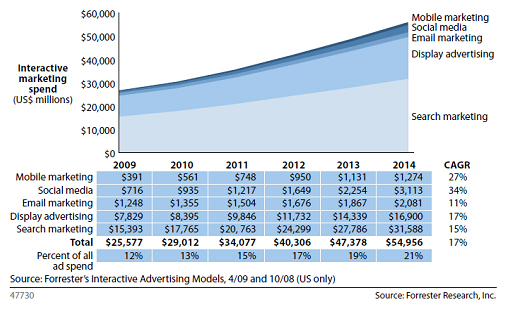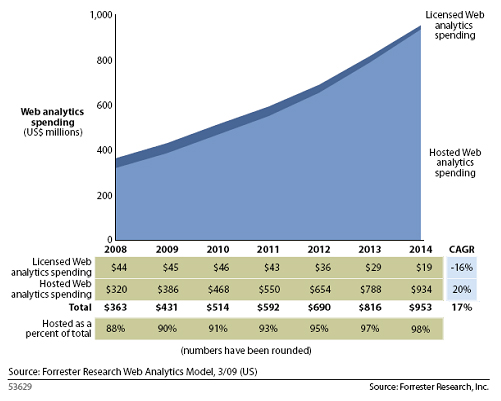Adobe’s unprecedented multi-billion-dollar purchase of Omniture in 2009 signified how important web analytics is today and will continue to be in the future. As more companies move toward using interactive, multichannel marketing and social media, there is a tremendous need to be able to effectively use the millions of data records they collect from their websites and other interactive technology. It is no longer just about page views or click-throughs, but instead the focus is on understanding who is visiting your website and how you can use their information to change your marketing to become more customer-centric and targeted. With the need to be able to extract, analyze, segment, and interpret data, the web analytics market is going to grow at an amazing pace over the next few years.
Forrester’s US Web Analytics Forecast, 2008 to 2014 white paper indicates that online media will overtake all other media in the not-to-distance future—and it’s already starting. Forrester predicts that multichannel interactive marketing expenditures will grow to $55B by 2014, with mobile marketing and social media having 27% and 34% CAGRs, respectively. Bango, the leading provider of payment and analytics products for mobile phone Internet businesses, recently did a study of 50 million worldwide mobile phone users and found that mobile web browsing had increased 600% over last year. Another example where we see a tremendous impact of online influence and marketing is in retail sales. Although e-commerce sales are only 6% of total retail sales, Forrester estimates that 40% of all retail sales are influenced by online research. So just because people may not be converting on your website, it does not mean they are not looking at it or even using it to motivate them to make their purchases.
With the amount of data that will be generated and the necessity to analyze and measure conversions and customer/website performance, the web analytics industry will grow. Forrester predicts that “US businesses will spend $953 million dollars on Web analytics in 2014, with an average compound annual growth rate (CAGR) of 17%.” Web analytics will be the key driver that enables companies to optimize their marketing strategies and turn data-driven recommendations into actionable strategies. Forrester states, “With Web analytics data as the foundation, marketers will formulate automated presentation methods that deliver relevant content and messaging to consumers in dynamic fashion.”
With growth comes innovation and today’s web analytics tools offer powerful features that will enable you to gain insight into who your visitors are, how your online campaign is influencing online and offline sales, and how your website is performing. Today’s solutions also enable you to segment your online customers and optimize your communication and website to meet different and changing needs, in addition to creating dashboards with funnels that show you how customers move through your site and where they may encounter an obstacle and leave.
Don’t worry, you don’t need to spend your entire budget on these solutions (see Figure 3 for a study done by Istobe on 520 websites). According to Forrester, “Some very large sites (those with monthly traffic exceeding 10 million unique visitors) spend in excess of $200,000 annually on Web analytics technology. However, industry averages hover around $15,000 per year for hosted solutions. The big spenders on hosted Web analytics represent less than 2% of the entire hosted customer base, with the majority of sites in the smaller traffic categories.” Having affordable and even free solutions will continue to increase the usage and impact web analytics tools have on your business. Of course, these figures don’t cover the cost of implementing and monitoring these tools – whether you develop this capability in-house or use external support can impact your budget significantly.
Today, web analytics may play only a small part in how you develop your marketing strategies and understand your customers. However, with exceptional predicted growth in the web analytics industry and the development of powerful and affordable tools, web analytics is going to play an increasingly bigger role in developing your marketing strategies and campaigns.
Resources:
US Web Analytics Forecast, 2008 to 2014 (Forrester)
US Interactive Marketing Forecast, 2009 to 2014 (Forrester)
Smartphone market drives 600% growth in mobile web usage. (Bango)
E-Commerce Web Analytics Market Share. (Istobe)
About the Author:
Lindsay Morgan is a Marketing Analyst with SIGMA Marketing Group.





{ 1 trackback }